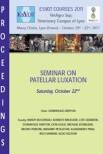Objective
To describe regions of the thoracic and pelvic limb proximal interphalangeal (PIP) joints that are arthroscopically accessible and identify soft tissue structures that should be avoided during arthroscope and instrument placement.
Study Design
Experimental ex vivo descriptive study.
Animals
Horses (n = 15).
Methods
Cadaver limbs (n = 36) were used for anatomic modeling, magnetic resonance imaging (MRI) with MRI-compatible needles, computed tomography with contrast arthrography, and arthroscopy of the PIP joint. Two arthroscopic approaches to the dorsal joint pouch were compared.
Results
With arthroscopy, 62.4% of the joint perimeter could be observed from the dorsal and palmar/plantar joint pouches with no significant difference in the amount of joint observed when using the more proximal or distal approach to the dorsal joint pouch (P =.59).
Conclusion
The dorsal and palmar/plantar joint pouches provide adequate arthroscopic visibility for the axial portions of the articular surface of the proximal and middle phalanx. The abaxial portions of the articular surface were difficult to view because of narrowing of the joint pouches abaxially. When comparing the proximal and distal approach to the dorsal joint pouch, arthroscope insertion 1.5 cm proximal to the joint allowed the easiest manipulation of the arthroscope. Palmar/plantar portals were placed dorsal to the neurovascular bundle, proximal to the epicondyle of the middle phalanx to prevent tendon and ligament injury.









